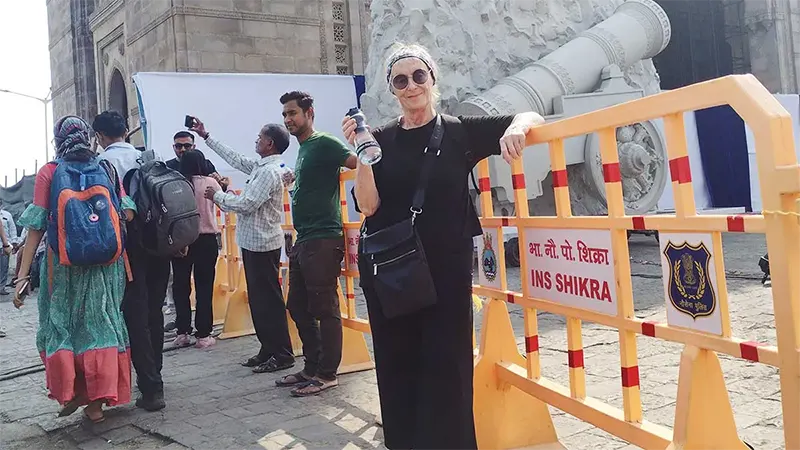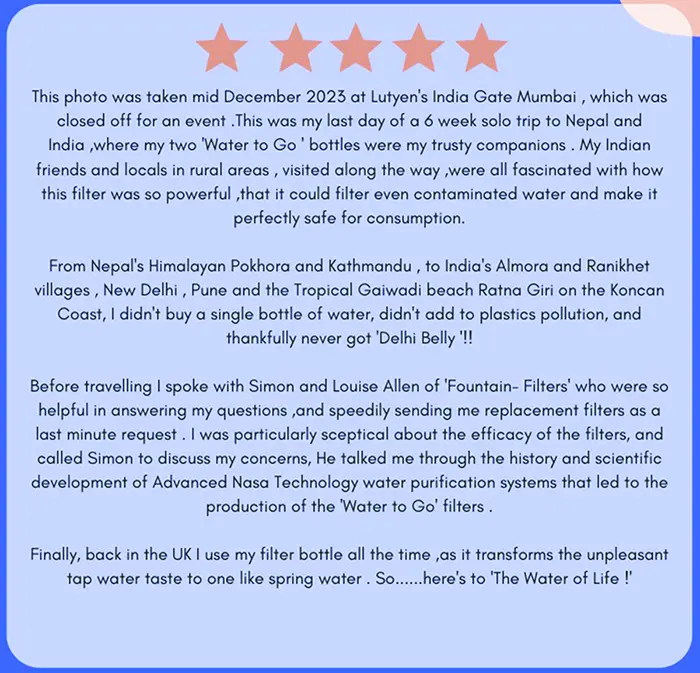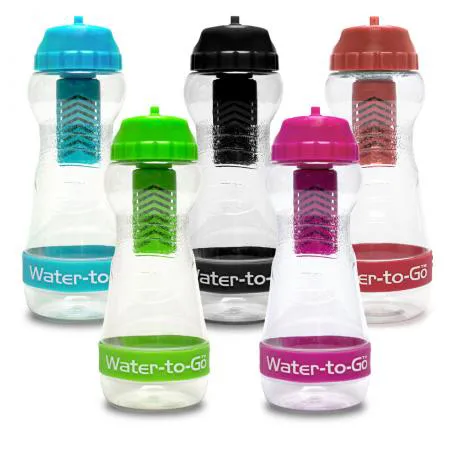Best ways filter water hiking backpacking
- Products
- by Louise
- 22-02-2024

Best ways to filter water when hiking or backpacking. A real backpacker’s advice!
Are you a keen hiker or backpacker and want to drink safe water during your travels and adventures? In that case, we would like you to meet Ann.
Ann embarked on a six-week solo trip to Nepal and India and describes her hiking water filter as her ‘trusty companion’.
Her Indian friends and other individuals she met along the way, some of which lived in very remote areas, were fascinated with her filtering water bottle for hiking and how it worked.
They were fascinated at just how powerful Ann’s backpacking water filter was. The fact that her water filter bottles could filter contaminated water and make it perfectly safe to drink blew their minds.
From Nepal’s Himalayan Pokhora and Kathmandu to India’s Almora and Ranikhet villages, New Delhi, Pune and the tropical Gaiwadi beach to Ratna Giri on the Koncan Coast, Ann didn’t buy one single bottle of water, didn’t add to the global plastics crisis, saved money, and to top it all off, didn’t get Delhi belly.
Ann had a truly fantastic experience, and we are especially happy that she invested in the best hiking water filter in the UK and decided to share her on the go water filtration experience with us! Thanks Ann!
We’d like you to grab hold of the best hiking water filter too, so sit back and read all about water filter bottles and other ways to filter water when hiking or backpacking.
 How do you filter water when hiking or backpacking?
How do you filter water when hiking or backpacking?
Firstly, if you’re away from home and out on the trails, never let your common sense be trumped by your thirst. And never be so gullible as to believe that the clear, pristine looking water in front of you is safe to drink. Use your imagination and think about what hazards could lie upstream.
You do not want to run the risk of drinking water that contains parasites such as Giardia or Cryptosporidium while out hiking. You’d be doubled over in pain and popping the antibiotics in for a good few weeks. It would ruin any outdoors adventure.
We know that you can just visit the supermarket and fill your backpack with bottles of water before you head off, but why do that when there are far easier, less heavy, cheaper, and more environmentally friendly ways to make the water that’s already outdoors perfectly safe to drink.
Just like Ann did.
Now that we’ve got your eyes wide open about the dangers that could be lurking in that clean, clear pool of water you’ve just stumbled upon, let’s look briefly at the commonly used ways you can make water safe before drinking it. As with everything, we recommend doing some of your own research on each of the different ways as you are the expert on what type of hiking, you’re going to be doing and how many are going to be involved on each trip.
Ann did her hiking water filter research before deciding that the water filter bottle was going to be the best way to filter water when she was exploring India and Nepal.
UV light to filter water outdoors
It’s hard to believe that sticking a pen like device in your water bottle and swirling the UV light around for 90 seconds or so will kill nasty contaminants and make the water safe to drink, but it does.
This easy-to-use gadget requires solar power or rechargeable batteries and will only filter one bottle of water at a time.
A downside is that the UV light doesn’t work so effectively on water that’s cloudy due to the amount of sediment that’s present. The cloudiness will stop the germs being exposed to the UV light. This type of filter will also not work on water bladders.
Gravity water filters for large groups of hikers or backpackers
Use the power of gravity to push dirty water down through a filter to make clean water. Gravity filters are incredibly easy to operate, you just need to remember to hang the dirty water higher than the clean water pouch otherwise gravity can’t do its thing.
If you have a larger number of people out hiking and backpacking, then gravity water filters are useful because you can filter larger quantities of water more quickly.
Pumps for filtering large quantity of water
You can give your arms a good workout and get the heart rate elevated with a pump filter.
Water is pumped through a filter system that traps contaminants. Pumps are easy to use and quick at filtering larger quantities of water, so useful if there are more than a couple of people in the party.
Liquids or tablets to purify water when travelling
Using liquids or tablets to purify water is classed as a chemical treatment.
The liquid must be measured out accurately and this can be a bit of a faff. You don’t need a lot, 1 ml per 10 litres of water is sufficient.
Water treatment tablets, while not instant, are much easier to use than liquid.
Chlorine dioxide purification tablets tend to be preferred over iodine tablets. As chlorine dioxide tablets dissolve, they purify the water with a highly active form of oxygen. Iodine doesn’t eliminate Cryptosporidium and can make the water turn yellow and taste horrible. That horrible taste would still be better than watery diarrhoea, stomach cramps, dehydration, nausea, vomiting, and fever.
After dropping one tablet per litre of water, you must wait at least 30 minutes to eliminate viruses and bacteria, two hours to get rid of Giardia, and if using Iodine tablets, up to four hours if there is a possibility that Cryptosporidium is present.
Straw filters to filter water whilst hiking
If you are out hiking and there is plenty of water around, then a very personal hiking water filter that you wouldn’t share with anyone else would be a straw filter.
Not so useful if there isn’t a plentiful supply of water on your hiking trip.
Boiling the water
We’re getting back to basics here!
Bringing water to a rolling boil in low altitude environments for 1 minute, or 3 minutes for altitudes above 2000m will ensure your water is potable as bacteria, protozoa and even viruses will have been eliminated.
You’re going to need to boil water for cooking, so boil enough for drinking to, and fill up your vessels for the day ahead.
Getting your camping stove out to boil water each time you wanted a drink wouldn’t be the best use of your time and it would also deplete your cooking fuel more rapidly than you’d like. But, planning to boil enough to drink when you’re cooking is a good use of time and resources.
Just to keep you hanging, we’ve saved what we believe to be the best water filter purifier for backpacking until last.
 Water filter bottles for hiking and backpacking
Water filter bottles for hiking and backpacking
This is what Ann chose. Be like Ann!
We all know that prevention is better than cure, so when you’re organising the essential items to fill your backpack make sure that at least a couple of 75cl water filter bottles are on your essentials list, plus an easy water bottle replacement filter.
It’s a simple strategy that’s worthwhile adopting to avoid tummy trouble from drinking water that could be full of bacteria, viruses, and protozoa. You should never have to worry about staying hydrated during any activity. Having access to clean water when travelling is vital, both to your body and to your overall enjoyment when hiking.
Be prepared like Ann.
We choose to offer water filter hiking bottles by Water to Go, a British company that started manufacturing water filter bottles in 2014.
They are the best backpacking water filter because you don’t have to mess about with liquids, tablets, gravity, pumps, UV, or straws. Depending on how far you’re going, you just grab your water to go bottles and off you go.
A 75cl bottle contains a filter that will be good for 200 litres of water, and the 50cl bottle will be good for 130 litres. That should last you for a good few hiking and backpacking adventures.
A classic combination of boiling water when you’re in situ and a water filter bottle are the perfect double act when it comes to outdoor adventure.
What is a water filter bottle?
You’ve heard of NASA right?.
Well, the 3-in-1 filter technology that sits inside this BPA free water filter bottle is based on that which was developed for the NASA space programme.
These bottles will remove up to 99.9999% of microbiological contaminants from any non-saltwater source through a process of traditional and nano technology.
What does a water filter bottle remove?
A Water to Go filtering water bottle for hiking will remove:
- bacteria
- viruses
- waterborne parasites
- protozoa
- heavy metals e.g. lead
- harmful chemicals
- chlorine
- fluoride
- microplastics
But it will retain:
- calcium
- magnesium
- sodium
What makes water filter bottles so unique?
A 50cl water filter bottle replaces 260 single use 500ml plastic water bottles and a 75cl bottle replaces 400 single use 500ml bottles.
By choosing to use what we consider to be the best hiking water filter you’ll be doing crazy amounts of good stuff for the planet.
You won’t ever have to buy bottled water again and considering that using a water filter bottle will cost you about 5p per litre, you’ll be wealthier to! Bottled water is SO EXPENSIVE.
We are here to help on all your outdoor water filtration needs!
Ann had lots of questions about the water filter bottle replacement filters and the efficacy of the filters.
Instead of sitting and worrying about it, Ann called us to chat over her concerns and we were able to talk about the history and scientific development of nano water purification technology that led to the production of the Water to Go bottles.
Ann’s now back in the UK and still uses her water filter bottle as in her words, “it transforms the unpleasant tap water taste to one like spring water.”
If you’re looking at the best way to filter water when hiking or backpacking and have questions, then we’re easy to get in touch with.
Call 01352 838 281 or send us a message and we’d be delighted to help you plan the adventure of a lifetime.


